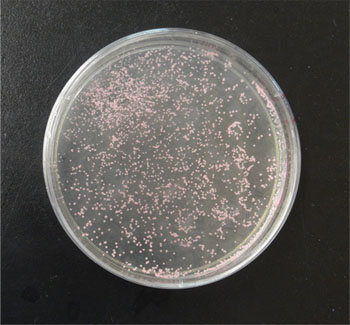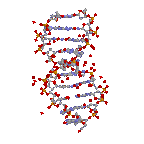|
Preparing New Halo Cultures

From liquid culture to a new liquid culture:
1. Add 1mL of Halo liquid inoculum to 50mL of Complete Medium in 250mL flask.
2. Add 0.5mL of Halo liquid culture to 50mL of Complete Media. (Amount added is depended on OD of original Halo, should be very pink & opaque , OD – 1.2 or – 1.5)
3. Incubate at about 220 rpm and 37°C. Check in 2-3 days. Full culture should be apparent in about one week. Fully cover flask (Al foil)
From plate to liquid:
1. Add 50mL CM to 250mL flask (Use autoclaved material for 2.0-2.5M salinity. ok to not use for greater salinity)
2. Take micropipette tip
3. Find a single pink colony
4. Gently use tip to remove colony
5. Drop tip and colony into flask with 50 mL CM
6. Swirl and cover
7. Incubate at 220 rpm and 37°C.
To inoculate plates:
1. Must use a small # of cells , Beginning OD 1.2 – 1.5
2. Dilute 1/2000 (1µL to 2µL )
3. Then dilute again by 1/20,000 (Take 1/2000 dilution and dilute 20 fold, Therefore 10µL and 90µL of CM)
4. Add 20µL of diluted Halo to the center of the agar plate , use 2% agar plates
If using metal spreader:
5. Using a sterilized metal spreader, spread cells over entire plate (Sterilize spreader
by soaking in ethanol, best to soak for about 10 minutes. Use a Bunsen burner to heat spreader.
6. Wait until cool. Test by putting spreader on agar not covered with Halo. If sizzles, wait
If using glass beads to spread cells:
1. Use sterile beads (autoclaved or use 70% ethanol or isopropyl. Then rinse with deionized water)
2. Add 20-25 (or 20-40; depends on size of plate) sterile beats to plate
3. Add 20µof diluted Halo to plate, Drop right in the middle of plate
4. Cover, and shake beads across numerous times
5. Uncover and put beats in container to later clean
6. Recover plate
7. Always store plates "upside-down" with agar showing on top
8. Label plates by writing around the outside edge. This down not distract/impede viewing of colonies
9. Place all plates in a Ziploc bag then incubate at 37°C. Check plates after 2-3 days. Should be ready in 1 week
10. If there are no individual colonies, only long streaks, too many cells were used to begin with
11. Do not use parafilm around plates, Okay for awhile, but the heat releases the parafilm so you’ll need to readjust
Making Agar plates:
1. Add 12g Bacterio-agar to 600mL CM
2. Add slowly while stirring at low temperature, if bubbles, lower temperature
3. Solution should not have large particles in it, but will be slightly cloudy, Precipitate forms if heated too much or too quickly
4. If using an autoclave, mix in a flask, then autoclave
5. Keep on a 55 °C water bath to liquefy.
6. Pour into petri plate (bottom) or a flacon tube for a future stab (6mL)
7. Tilt tube at a significant angle (120°), Use a pen or like object to prop tubes up at this angle (This surface area is for smear )
Making Complete Media (CM):
1. In a 2 L bottle, add 500-600 mL of DI water.
2. Place a stir bar inside the 2 L bottle, and place on a stir plate. Turn on the stir plate.
3. Add 250 g of NaCl
4. Add 20 g of MgSO4 7H20
5. Add 2 g of KCl
6. Add 3 g of Na Citrale
7. Add 10 g of Oxoid Peptone
8. Add more DI water until total volume is 1 L (If you want to make a larger volume, like 4 L of CM, multiply everything by 4, so you will need 1,000 g of NaCl etc.)
9. After all of the solids have dissolved, replace lid on bottle and cover with foil and autoclave tape. Autoclave CM.
[back to top]
|


